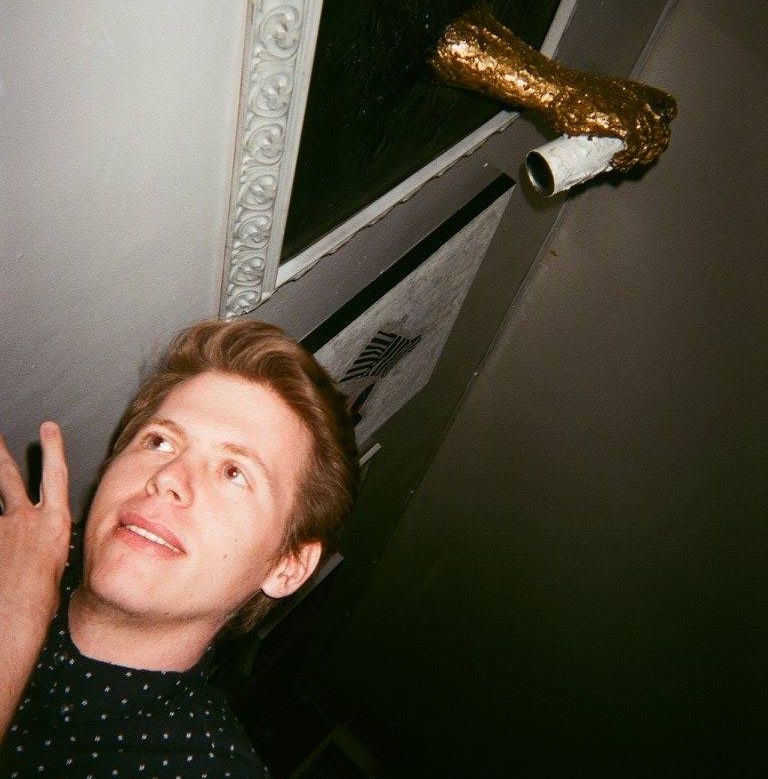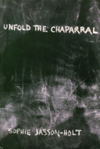ISSN: 1941-4137
POETRY THAT ENACTS THE ARTISTIC AND CREATIVE PURITY OF GLASS
POETRY THAT ENACTS THE ARTISTIC AND CREATIVE PURITY OF GLASS

Lucas Bailor is from Moreno Valley, California and is an incoming MFA candidate at UC San Diego. His long poem, Love's Refrain, was published in Ghost City Press' 2018 micro-chapbook summer series, and his poems have appeared in HVTN, SHARKPACK Poetry Review, and elsewhere. He occasionally tweets @lucasbailor.
August 2, 2018
Edited by Stephanie Kaylor
#TBT Reviews Series
Edited by Stephanie Kaylor
#TBT Reviews Series
Review of Unfold the Chaparral by Sophie Jasson-Holt
 Unfold the Chaparral
by Sophie Jasson-Holt
Fourteen Hills Press, 1996
Anyone who frequents used bookstores or thrift stores knows that, more often than not, you’ll walk out with nothing or little to show for your visit. Even when you do walk out with something, it might just be that book you haven’t read yet but aren’t necessarily putting at the top of your to-read list, or a functional sweater you’ll occasionally forget you have. But, of course, the reason to keep going back to such a store is the simple possibility of finding something spectacular. As soon as I picked up Sophie Jasson-Holt’s Unfold the Chaparral at $10 Or Less Bookstore in Northridge, California, I knew it was such a find.
Finding a used book of poetry that stuns, however, has proved consistently incredibly hard for me. Usually poetry sections in used bookstores take up a shelf or two, maybe a small wall. There will be the classic authors, some anthologies, plenty of books that just don’t interest me in the slightest, etc. But I do always return to the local used bookstores just in case I’ll have that good find. What’s particularly special about Jasson-Holt’s Unfold the Chaparral is imagining the trip it must have taken to get to where I was in Southern California. The winner of the 1996 Michael Rubin Award—an award that meant getting published through San Francisco State University’s Chapbook Series—the book only had to travel down the state, but due to there being little information I could find on the book online, I’m still left wondering what series of events led to it arriving in a used bookstore in the San Fernando Valley.
But this being the context of the book for me ended up a perfect fit alongside the work itself. The first poem, “Morning,” highlights a feature of much of the collection, where any given line can be read by itself or in connection with the lines surrounding it:
on the quiet road to work
the sun’s stark orange coming on
too low for trees to make their shadows
I hit a crow at 6:00 a.m.
(she was) sweeping crumbs
scattered
Do we read the first three lines and the second three as a single part of a narrative? As two separate narratives? As six different moments? The possibility of any given option is exactly what made me realize I made a good choice in picking this book up. Looking at the second set of three, Jasson-Holt hitting the crow doesn’t necessarily mean that the crow was sweeping crumbs, or that the crow or the crumbs are what is scattered. Presenting the lines in such a way gives way to that reading, but it doesn’t make it necessary.
Furthermore, one of the consistent trends in the collection is Jasson-Holt’s willingness to constantly shift how any given poem — or excerpt of a poem — is presented on the page. This particularly fits her aesthetic approach of leaving plenty of room for the reader to step in with their interpretation while, presumably, having her own specific ideas in mind. Take the excerpt of prose poetry that begins the section, “towards God we married,” for example:
"We walked in the rain. Petals burned the swollen. A hot ocean boiled in Public. You said ‘only once’ — smoking hearts, over coffee we would change our legends. At the grit of breakfast you asked ‘how was it.’ On the wet road, we hitched a ride towards the altar, a purple star. Drunk in a cup of fire. We approached an open tower, full of wind."
This reminds me most clearly of Lyn Hejinian’s My Life, a work that presents memory as it happens rather than in the usual chronological autobiography. Here the reader is not filled in on the details and instead is left to look at primarily the language. Unfold the Chaparral is a constant reminder that perhaps the most interesting interpretation of a given poem is not what it’s “about,” but rather how the language operates and coalesces into any number of images or ideas.
In fact, it is precisely Jasson-Holt’s use of interesting phrases and bits of language that has kept this collection on my mind long after the initial reading. Following are some examples: “a canal is gouged with tooth”; “a weeping rock / holds the in between”; “Crown the organ(s) / let go”; “unthread the sob”; “grass & sun slipped”; “ripe in the after / fields of water weep.” With each full poem or section of a poem, Jasson-Holt shows a complete diving into language in order to excavate more from experience than just what happened, resulting in a poetics that is often fragmented and abstract, but also entirely captivating.
There is much to say about this collection — and much that has informed me on my own writing — simply because Jasson-Holt gives so much in the collection: so much variety, so much memory, so much language to sift through. So it’s only fitting that Jasson-Holt ends the collection in the way that she does:
& a Crown holds the rotation
over bodies of water
across continents
this ring drops
The reader is again left with something that isn’t necessarily easy to uncover, but instead something to simply sit with and hold. Jasson-Holt doesn’t leave us with tightly knotted ends, but instead presents all the various threads of all the words and phrases introduced throughout the collection. Rather than necessarily presenting an exact, crafted object, Unfold the Chaparral presents another option: What did she craft with these words? What have we?
Visit Fourteen Hills Press' Website
Unfold the Chaparral
by Sophie Jasson-Holt
Fourteen Hills Press, 1996
Anyone who frequents used bookstores or thrift stores knows that, more often than not, you’ll walk out with nothing or little to show for your visit. Even when you do walk out with something, it might just be that book you haven’t read yet but aren’t necessarily putting at the top of your to-read list, or a functional sweater you’ll occasionally forget you have. But, of course, the reason to keep going back to such a store is the simple possibility of finding something spectacular. As soon as I picked up Sophie Jasson-Holt’s Unfold the Chaparral at $10 Or Less Bookstore in Northridge, California, I knew it was such a find.
Finding a used book of poetry that stuns, however, has proved consistently incredibly hard for me. Usually poetry sections in used bookstores take up a shelf or two, maybe a small wall. There will be the classic authors, some anthologies, plenty of books that just don’t interest me in the slightest, etc. But I do always return to the local used bookstores just in case I’ll have that good find. What’s particularly special about Jasson-Holt’s Unfold the Chaparral is imagining the trip it must have taken to get to where I was in Southern California. The winner of the 1996 Michael Rubin Award—an award that meant getting published through San Francisco State University’s Chapbook Series—the book only had to travel down the state, but due to there being little information I could find on the book online, I’m still left wondering what series of events led to it arriving in a used bookstore in the San Fernando Valley.
But this being the context of the book for me ended up a perfect fit alongside the work itself. The first poem, “Morning,” highlights a feature of much of the collection, where any given line can be read by itself or in connection with the lines surrounding it:
on the quiet road to work
the sun’s stark orange coming on
too low for trees to make their shadows
I hit a crow at 6:00 a.m.
(she was) sweeping crumbs
scattered
Do we read the first three lines and the second three as a single part of a narrative? As two separate narratives? As six different moments? The possibility of any given option is exactly what made me realize I made a good choice in picking this book up. Looking at the second set of three, Jasson-Holt hitting the crow doesn’t necessarily mean that the crow was sweeping crumbs, or that the crow or the crumbs are what is scattered. Presenting the lines in such a way gives way to that reading, but it doesn’t make it necessary.
Furthermore, one of the consistent trends in the collection is Jasson-Holt’s willingness to constantly shift how any given poem — or excerpt of a poem — is presented on the page. This particularly fits her aesthetic approach of leaving plenty of room for the reader to step in with their interpretation while, presumably, having her own specific ideas in mind. Take the excerpt of prose poetry that begins the section, “towards God we married,” for example:
"We walked in the rain. Petals burned the swollen. A hot ocean boiled in Public. You said ‘only once’ — smoking hearts, over coffee we would change our legends. At the grit of breakfast you asked ‘how was it.’ On the wet road, we hitched a ride towards the altar, a purple star. Drunk in a cup of fire. We approached an open tower, full of wind."
This reminds me most clearly of Lyn Hejinian’s My Life, a work that presents memory as it happens rather than in the usual chronological autobiography. Here the reader is not filled in on the details and instead is left to look at primarily the language. Unfold the Chaparral is a constant reminder that perhaps the most interesting interpretation of a given poem is not what it’s “about,” but rather how the language operates and coalesces into any number of images or ideas.
In fact, it is precisely Jasson-Holt’s use of interesting phrases and bits of language that has kept this collection on my mind long after the initial reading. Following are some examples: “a canal is gouged with tooth”; “a weeping rock / holds the in between”; “Crown the organ(s) / let go”; “unthread the sob”; “grass & sun slipped”; “ripe in the after / fields of water weep.” With each full poem or section of a poem, Jasson-Holt shows a complete diving into language in order to excavate more from experience than just what happened, resulting in a poetics that is often fragmented and abstract, but also entirely captivating.
There is much to say about this collection — and much that has informed me on my own writing — simply because Jasson-Holt gives so much in the collection: so much variety, so much memory, so much language to sift through. So it’s only fitting that Jasson-Holt ends the collection in the way that she does:
& a Crown holds the rotation
over bodies of water
across continents
this ring drops
The reader is again left with something that isn’t necessarily easy to uncover, but instead something to simply sit with and hold. Jasson-Holt doesn’t leave us with tightly knotted ends, but instead presents all the various threads of all the words and phrases introduced throughout the collection. Rather than necessarily presenting an exact, crafted object, Unfold the Chaparral presents another option: What did she craft with these words? What have we?
Visit Fourteen Hills Press' Website
Glass: A Journal of Poetry is published monthly by Glass Poetry Press.
All contents © the author.
All contents © the author.





